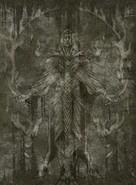- Not to be confused with Nordic Pantheon.
The Ancient Nordic Pantheon, not to be confused with the later Nordic Pantheon, was the set of deities venerated by the Atmorans and early Nords of the Merethic Era and early First Era.[1]
History
The faith originated in Atmora in the Merethic Era where Dragons ruled supreme. Their servants, the Dragon Priests established a ruling body known as the Dragon Cult and held power equals to kings.[1]
Part of the cult's beliefs was a faith focused on the worship of animal gods. The deified animals were the hawk, wolf, snake, moth, owl, whale, bear, fox, and the dragon.[1] Low reliefs found in ancient Nordic ruins have led scholars to believe that these deified animals were actually totemic representations of several Et'Ada, some of which are present in the pantheon of the Eight Divines. Of these reliefs; six are depicted as male and three as female.
Influence in Skyrim
The Ancient Nordic Pantheon was brought to the shores of Skyrim during the mass Atmoran migration that took place over the next several centuries.[1] It served as the predominant Nordic faith during the early First Era, however over the centuries the Nords eventually discarded the notion of animal worship and moved towards the worship of the Et'Ada themselves. This culminated in the formation of the Nordic Pantheon which served as the predominant religion in Skyrim until the rule of Alessia in 1E 243, who melded Aldmeri and Nordic pantheons to create the pantheon of the Eight Divines.[2]
Animal gods
The Dead Gods
Fox

The fox depicted as a male and is believed to be the representation of Shor, the fallen god-hero of mankind. Allusion to the characteristics of the fox include his successful attempt at persuading his fellow Et'ada to create Mundus.[UL 1][3]
Bear

The bear depicted as a male and is believed to be the representation of Tsun, Nordic god of trials against adversity.[UL 1] He served as shield-thane to Shor and died defending him from foreign gods during the Ehlnofey wars of the Dawn Era.[3]
In the Nordic afterlife of Sovngarde he guards the Whalebone bridge.[4][UL 2]
The Hearth Gods
Hawk

The hawk depicted as a female and is believed to be the representation of Kyne, warrior-widow of Shor, also known as the Goddess of the storm and the Mother of Men.[UL 1][3] Nords believe she was instrumental in both their creation and for giving them the gift of the Thu'um.[5][6][3]
Wolf

The wolf depicted as a female and is believed to be the representation of Mara, the Goddess of love and handmaiden of Kyne.[UL 1][3]
Moth

The moth depicted as a female and is believed to be the representation of Dibella, the Goddess of beauty.[UL 1]
Whale

The whale is depicted as a male and is believed to be the representation of Stuhn,[7][8] the Nordic precursor to Stendarr and brother of Tsun. Like his brother, he served as shield-thane to Shor, and fought against the Aldmeri Pantheon during the War of Manifest Metaphors.[3]
Owl

The owl is depicted as a male and is believed to be the representation of Jhunal,[7] the Nordic god of runes, hermetic orders, wisdom and knowledge. He is also known as the father of language and mathematics.[3]
The Testing Gods
Snake

The snake depicted as a male and is believed to be the representation of Orkey, who tricked the Nords into giving up their long lifespans, and "bound them to the count of winters."[UL 1][3]
The Twilight Gods
Dragon

The Dragon was the chief deity in the ancient Nordic pantheon as is widely accepted as being a representation of Alduin, the god of time, as well as the "World Eater."[UL 1] Low reliefs in ancient Nordic tombs don't depict them directly, rather their servants; the Dragon Priests are shown.









